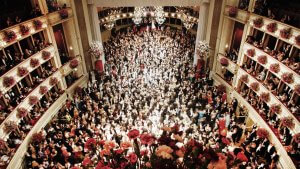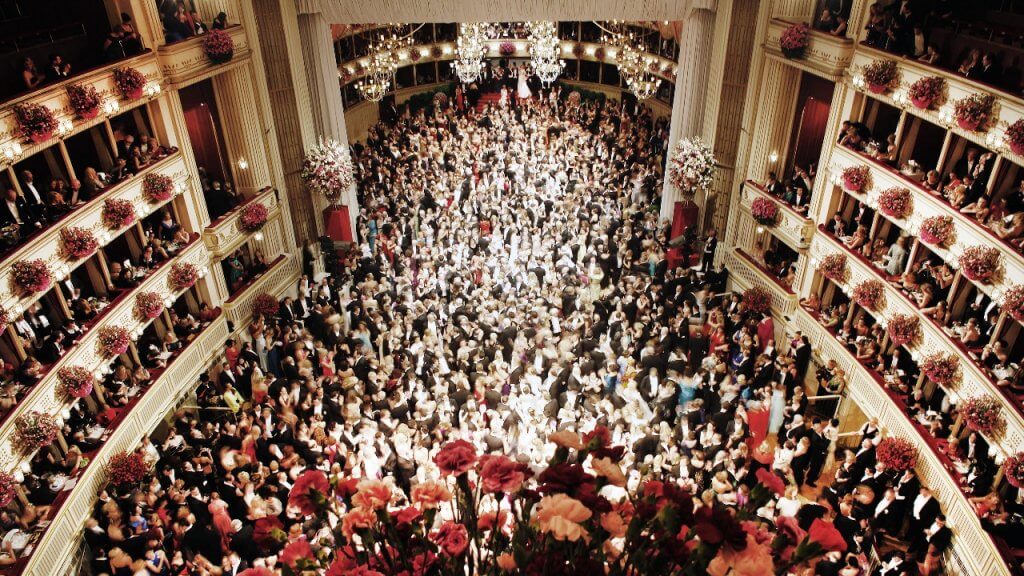Vienna – The Birthplace of the Ball

The capital of Austria is Vienna; an ancient European city that focuses on beauty, luxury and chic. Every year, in February and March, the most famous and magnificent balls take place here.
A bit of history
The history of Viennese balls goes back to the Middle Ages. It is known that the celebration, originally held in 1347 in honor of the Hungarian King, Ludwig the Great, took place every hour of every day for a full week, impressing all those who witnessed it with its magnificence and scope.
The heyday of Viennese balls came in the XIX century and is closely associated with the popularity of the waltz, a genre that is intimately connected with the ‘Waltz King’ himself, Johann Strauss. According to the testimony of historians, in the first half of the XIX century, during the Shrovetide, up to 250 balls were arranged every evening! Almost everyone participated in the dance, from aristocrats to ordinary people.
The Vienna Congress of 1814-1815, which brought together all of the most influential monarchs to decide the fate of post-war Europe, utilised the platform of the balls to offer not only festivities and dance, but also to create opportunities for greater diplomacy, as contemporaries noted.
At the end of the century, the Court Ball became one of the main events in the empire. Only the nobility were invited to it and the events that took place there usually involved spending a lot of time discussing issues surrounding Vienna. Yet, in 1899, mourning the death of his wife Elizabeth, Emperor Franz Joseph saw fit to abolish the Court Ball.
In 1921, the Opera Ball came to the forefront in terms of fashion and significance. It began its existence in the halls of the palace and was later moved to a new theatre built by orders of Franz Joseph in 1869. Well, the first really large-scale Opera Ball took place there on December 11, 1877 and the orchestra was led by Edward Strauss, junior brother of the famous maestro. A distinctive feature of the new ball was that the faces of the ladies had to be covered with masks and it was the women who chose their partners for the dance.
To this day, Vienna retains the title of the world capital of balls, and the Opera Ball is their king.
Ball season
The ball season in Vienna usually lasts from November 11th until Shrove Tuesday; the season of carnivals and masquerades. At this time in the Austrian capital, there are about 300 balls, each of which has its own name and traditions.
The most interesting ones are arranged in January-February. Among them: The balls of Viennese florists, restaurateurs, medical workers, lawyers, engineers, hunters, pharmacists, students and sexual minorities (the so-called “Rainbow Ball”). Even the Society of the Blind and Partially Sighted hold a ball. In these cases, the ball is not just a celebration of music and dance, but also an opportunity for people united by a profession or an idea to come together.
Each ball has its own unique charm. The Color Ball (Blumenball), for example, turns the Vienna City Hall into a sea of flowers, and the Bonbon-Ball, which used to be called Sweet Night, attracts visitors with sweet surprises. By the way, the Ball of Chocolates, held on February 28th in the Konzerthaus Concert Hall, this year is dedicated to Salzburg, the hometown of Mozart.
The first of the largest balls, the Imperial, is traditionally held on New Year’s Eve in the Hofburg – the winter palace of the Habsburg dynasty, now the official residence of the President of Austria. The atmosphere of the ball immerses the participants in the days of the monarchy, with appropriate music, including the waltzes of Strauss and Lehar, and the music of the Viennese classics – Mozart, Beethoven and Haydn.
However, without a doubt, the most important role, not only in Austria, but also in the whole of Europe, is played by the Opera Ball, which takes place in the middle of February in the building of the famous Viennese Opera. By importance, it is equivalent to a state reception and is usually chaired by the president of Austria. This is the only ball preceded by a dress rehearsal the day before.
The Opera Ball usually has up to 5,000 participants and it is served by about a thousand people, including musicians, chefs, tailors and even shoe masters (in case anyone breaks a heel at the height of the dance).
 Everybody is dancing!
Everybody is dancing!
To feel like Natasha Rostova or Prince Bolkonsky, one must not only be able to dance, but also look a certain way. So, men should definitely be in tails and ladies should be in long ball gowns. Importantly, appearing at two balls in the same outfit is considered bad form.
In the centre of Vienna, there is a boutique called Rohrr & Kretschmer, where politicians, stars and other rich and respected people choose their outfits for the ball. The cheapest dress here costs from 4,000 Euros, but exclusivity is guaranteed. More affordable options can be found in the salon Flossmann at Reimergasse, 11 (Singerstrasse corner). Quite low-cost (and sometimes good) options may be found in second-hand shops, at car boot sales or at flea markets. Do not forget about the possibility of renting ballroom attire.
The dance procession is traditionally opened by debutants (young girls from aristocratic families making their way into the world). Today, the noble origin of this tradition has ceased to be mandatory, even at the Opera Ball. Nonetheless, it is essential to observe an age limit of up to 25 years and to be selected by the organisers. It is the debutants, sometimes numbering 360 young girls, who own the right of the first dance. They open the Opera Ball with a solemn polonaise, and then the waltzing begins and everyone dances!
In addition to dancing, participants of the ball can be treated to a five-course meal, including selected delicacies. The celebration is crowned with the famous Viennese waltz.
One more old-fashioned ball tradition has been preserved, which is the “ladies’ contribution”, which is a small gift from the organisers. Medallions, fans with the name of the ball, souvenirs (like a crystal figure from Swarovski) or tiny books in a small chest can be provided. Everyone wants to have something in memory of the last evening!
Issue price
The price of tickets for balls depends on the event and on the place in the hall, but can cost between 100 and 16,000 Euros.
Official ticket prices, for example, at the Opera Ball can be viewed on the website of the Vienna Opera. A simple entry “dance” ticket, without a seat, in 2019, will cost 315 Euros. Renting a section for up to 12 people will run about 23,600 Euros. A table for six persons will cost 1260 Euros and a table for four will cost 840 Euros (for the entrance and the banquet, you will have to pay separately). For a modest double-digit amount, you can buy the right to simply watch the ball from different tiers of the balcony. Quite an economical option is to attend the dress rehearsal of the Vienna Ball, in standing room only or at a seat. All questions regarding tickets can be sent to [email protected].
It is better to take care of the purchase of tickets in advance, since, in a few months, they may not be available. For example, on the website of the Vienna Opera, all of the tickets have already been sold. They can still be purchased from resellers, but will be much more expensive.
The most honourable mission is the discovery of the Opera Ball. Good dancers can get to the ball as debutants. To participate in the February event, you need to send, to the organisers, your application, with a biography, photo and video recording of a waltz with a left turn before September 1st. Participation in the ball is free for those selected – only rehearsals are paid for.
Recently, it has become fashionable to hold Viennese balls in different parts of the world – in Bangkok and Tokyo, in Dubai and New York, Budapest and Prague, in Istanbul, Rome and Moscow. Cyprus is no exception – on March 8th, the next annual Vienna Ball will take place in Nicosia!









